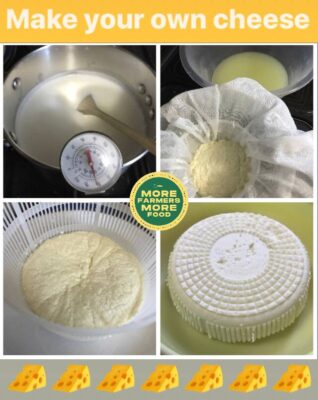Week 2 of the More Farmers More Food campaign discussed other types of dairy product
In this Article...
The benefits of dairy products.
Dairy is a staple food in many countries making it one of the most common types of food in the human diet. Recently, dairy has taken an absolute battering with lots of negativity being promoted regarding its consumption. There appears to be a rise in lactose intolerance in humans. Milk contains about 5% lactose by weight and processed dairy products contain much less. Some even suggest that going back to raw milk (and its products) might solve the problems that consuming a dead food source has caused. Some claim that dairy products cause inflammation but several large systematic studies have found that there’s little evidence for dairy having any inflammatory effect on the body. These studies demonstrated a neutral to beneficial effect of dairy on markers of inflammation.
We looked at butter and its benefits. It has a rich history dating back to ancient times, can be used as a natural moisturiser and has a role in traditional medicine. It is made by churning cream, a process that separates the fat solids from the liquid. What is left behind is known as buttermilk.
Butter comes in various forms such as salted, unsalted, clarified (ghee) and cultured. This creamy ingredient is a staple in kitchens around the world and contains vitamins A, D, E & K. These support healthy skin, brain function and bone health. Butter has a high smoke point, which means it can be heated to high temperatures, ideal for frying or sautéing food. Unlike processed margarine or veg oils, butter is a natural fat that is recognised and metabolised by the body easily.
Next, we looked at cheese. While the cheese making process might turn some stomachs with its vats of coagulated milk and mold. It’s one of the most scrumptious foods ever invented! The production of cheese predates recorded history beginning well over 7,000 years ago. In 17th century England cows had a grassy diet rich in beta carotene which tinted the cheese orange. Cheesemakers sometimes dye cheese with saffron, marigold, carrot juice or seeds of the annatto plant. Cheese rolling is a traditional sport in the region of Gloucester and blue cheese is made by injecting mold spores into cheese with long needles.
We discovered one of the most bizarre facts – it’s estimated that 4% of the world’s cheese ends up stolen.
Then we found out lots of interesting things about yoghurt and that it is one of the most popular foods in the world. It’s thought that many years ago herdsmen in the Middle East carrying milk in bags made of animal gut, discovered that contact with the intestinal enzymes may have caused the milk to curdle and sour. This led to the realisation that this product could be kept for a longer period. Yoghurt is versatile and nutritious, packed with protein, calcium, probiotics and phosphorous. It contains B vitamins and all 9 essential amino acids. Due to the fermentation process, yoghurt has a long shelf life compared to other dairy products. There is evidence that the live bacteria found in yoghurt can improve your mood.
The week finished off with looking at how you can make your own simple soft cheese.

🧀 Have you ever made your own cheese?
If you’re a beginner, I’d recommend starting with a cheese making kit. You can buy them online. They contain everything you will need (except the milk) along with detailed instructions.
🧀 Here are the basic steps of how to make cheese:
1.) Start with fresh warm milk.
2.) Acidify the milk.
3.) Add a coagulant.
4.) Test for gel firmness.
5.) Cut the curd.
6.) Stir, cook and wash the curd.
7.) Drain the curds.
8.) Salt and age the cheese.
Finally, we looked at all the other products made from dairy and came to the conclusion that dairy is a wonderful food source!
How will you be inspired by dairy products week?



